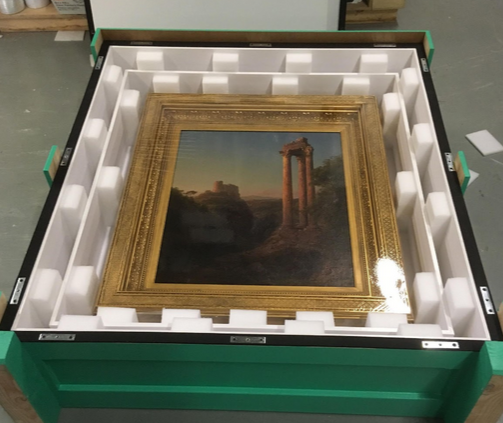Understanding Storage Of Fine Arts In Houston, Texas
The Biggest Risks To A Painting Or Other Works Of Art:
-Breakages, tears, loose and missing elements, impacts, and smudges.
-Fingerprints etched into polished surfaces.
-Stains and marks from skin contact, eating, smoking, cosmetics and other domestic chemicals.
-Introduction of materials and conditions that encourage pests or other environmental damage: foods, other infested objects, poor storage materials, central heating, damp, intense light.
The common link?
People.
People accidentally break, rip or spill their coffee onto their precious paintings. They store their art in a convenient place, like their moldy basement.
Follows These Steps When Packing A Painting.
Minimize contact. The first step to conserving oil paintings and other artwork during transportation or storage is to minimize human contact. An easy way to accomplish this is to create a barrier between you and the painting during the packing process.
Wrap in plastic. Use plastic to wrap the painting to keep it clean and protect the finish.
Seal with Styrofoam. Use a custom-sized Styrofoam box to ensure that the painting is safe and snug.
Put in a small box. Place the Styrofoam-packed painting into a close-fitting cardboard box. If you already have appropriately-sized boxes, use them. If you do not have a box, you can make one from a couple of good-sized sheets of cardboard and a box cutter.
Pack with dense packing material. Make sure that you fill any space with bubble pack to avoid bouncing or jarring in transit, then seal the entire apparatus shut with packing tape. Avoid peanuts or any packing material that can get smashed or settle over time.
Learn How To Transport A Painting With Care.
Be careful when driving. Make sure your painting won’t flop around, or worse, become a missile if you stop suddenly.
Store the painting vertically. When laying flat, something (or someone) could fall, flop or sit on your painting.
Protect the painting with other objects. If you must lay the artwork flat, slide the painting against something solid in case you have to stop quickly. Proactively minimize the opportunity for sudden impact. Bringing a blanket or pillow for extra cushioning is also recommended.
Pick a reliable carrier. Are you shipping the art through a professional carrier?
Each service — whether you are considering the United States Postal Service or a private company like FedEx or UPS — has unique rates, rules and standards for shipping based on the size and weight of your parcel. You can use an online calculator to compare rates to get an idea of what you will pay.
Insure against damage. You should also strongly consider purchasing shipping insurance since your work of art could be irreplaceable
Consider These Tips When Storing A Painting.
Never store artwork someplace dry or damp. Do not store paintings in a basement or attic. Choose someplace with consistent temperature and moderate humidity, like a climate controlled storage unit.
Don’t store paintings on top of each other. If you must lay your painting or paintings flat, use a rack to keep the artwork off the ground and each other. Frames and canvases can absorb dampness from concrete and other materials and can get distorted in the frame if there is too much weight on top of them.
Keep paintings away from fluctuating temperatures. If there is a furnace in your storage space, or inadequate heating or cooling, the sudden changes can damage your art.
Stay away from the sun. Direct sunlight can fade colors. Keep paintings covered with an acid-free cloth or leave the artwork in its travel packaging.
Don’t forget about the painting in storage. When storing paintings, it’s easy to toss it into storage and forget about it. The problem with this is that potential hazards can’t be monitored and remedied if you don’t check in every few months. Keep an eye out for signs of rodents or moisture and make corrections as needed.
Keep Paintings Safe Inside A Storage Unit.
If you plan to keep your art in storage for an extended period, consider working with professionals. Life Storage can provide climate and temperature controlled storage, clean, secure units and the peace of mind you don’t necessarily get when you keep paintings in the attic. Use our online guide to find storage locations near you.
CHOOSE A SPECIALIZED TRANSPORTER
If you are unfamiliar with the transportation of art pieces, we recommend that you use a specialized company that has all the necessary equipment and expertise. These professionals are specialized in the packaging and handling of precious and fragile objects. Some companies also offer specific types of transport in adapted vehicles equipped with performance suspensions or interior upholstery. Here at TyArt transporting artwork is our specialty!
ABOUT THE BUSINESS:
While dealing with artwork, it is best to seek professional help. TyArt is an art handling company, well known and recognized for its authentic services. We offer various services like an art installation, art carting, art storage, and picture hanging. For more information, contact us at 713-869-4044, write a mail to tyart@tyart.com, or fill the contact form.




Leave a Reply
Want to join the discussion?Feel free to contribute!